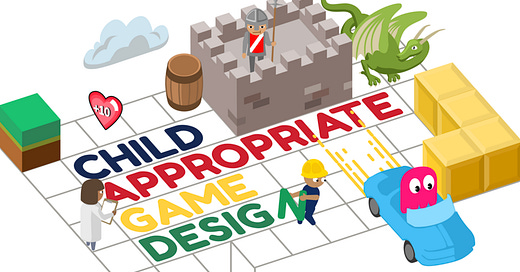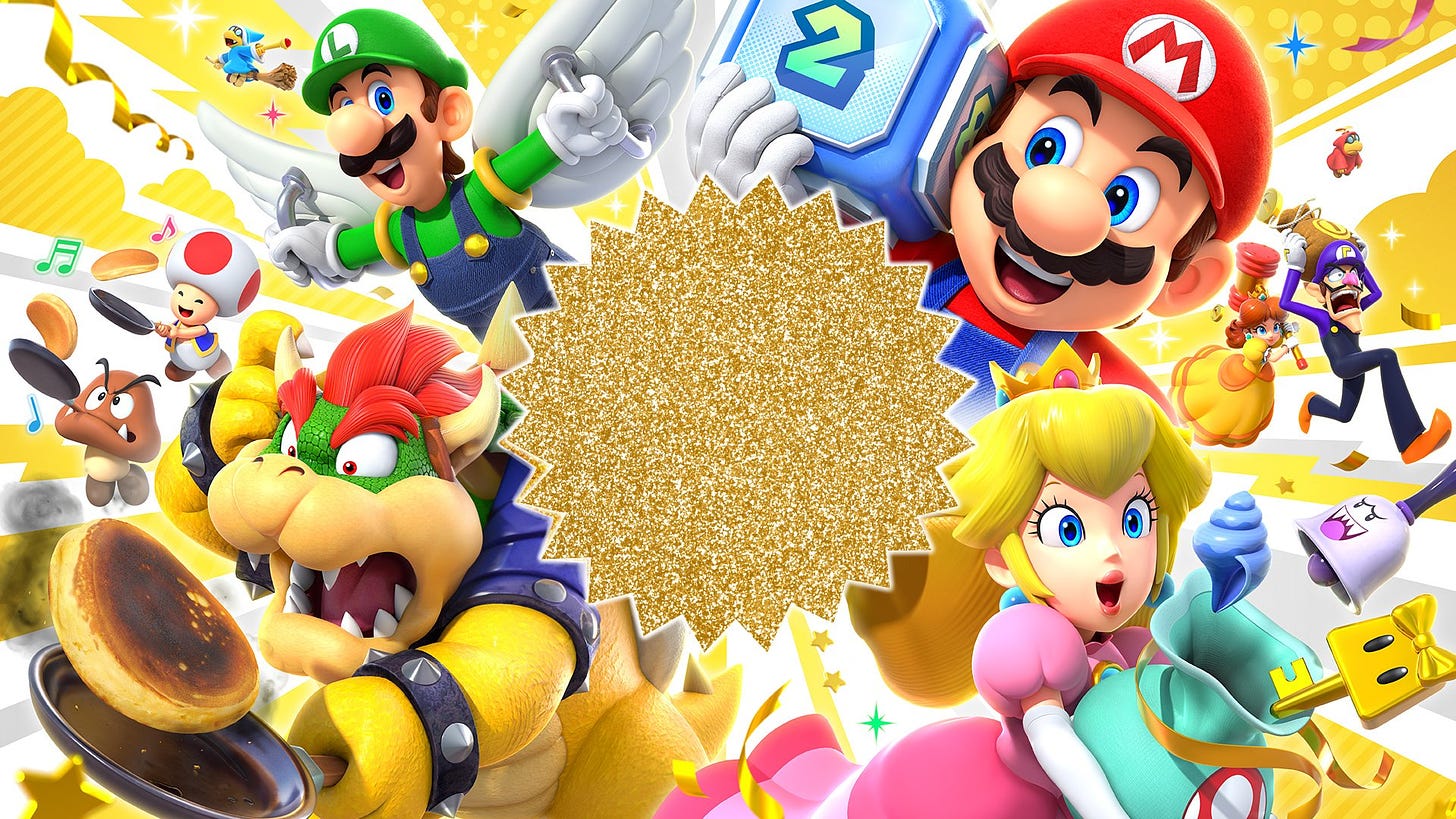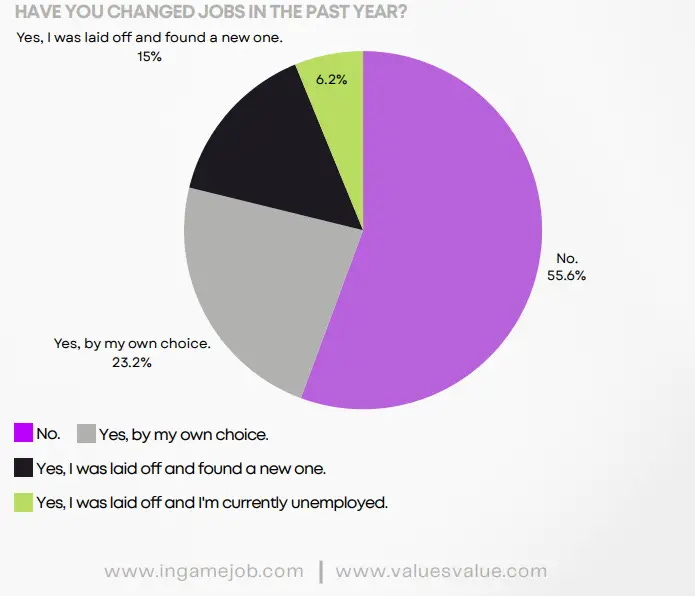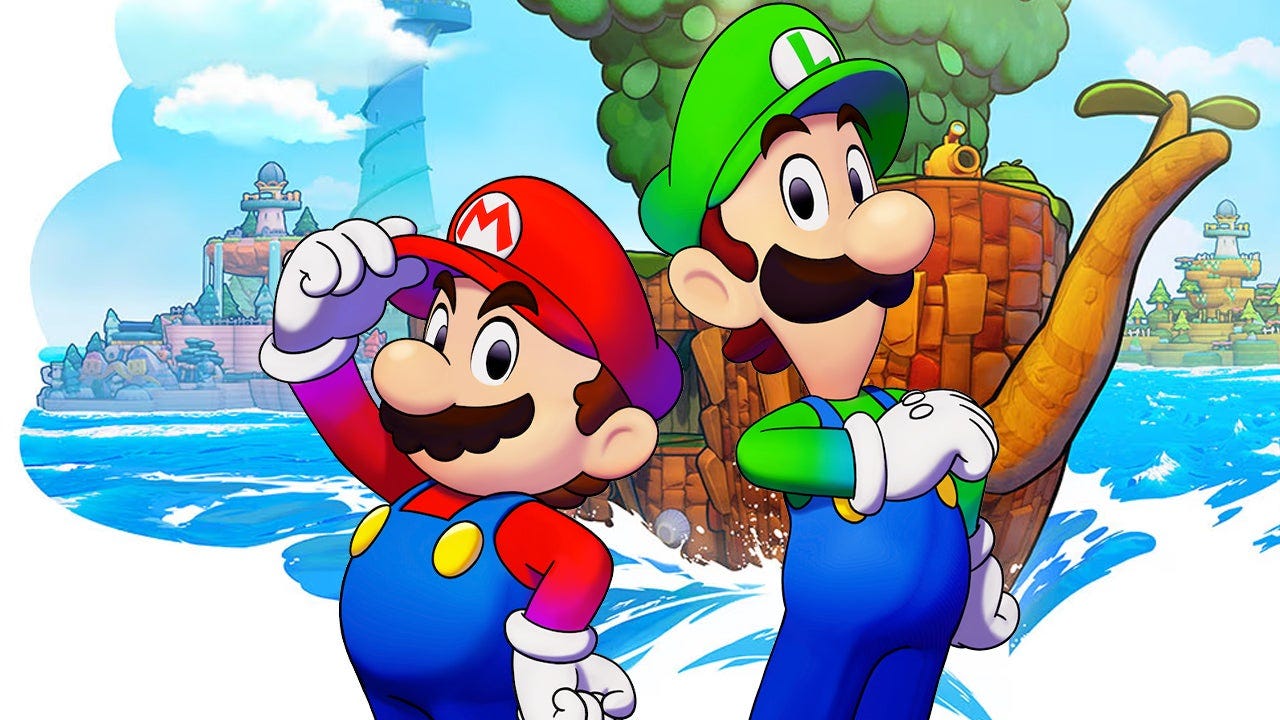What does “age appropriate” play mean to kids?, 07/11/2024
And why they’re better at defining it than most grown-ups are
I take a look at a new report examining what child’s play should be in games
Over 20% of Europe’s games industry was laid off last year, says survey
Mario & Luigi: Brothership jumps to top the week’s releases
Hello VGIM-ers,
America, eh? *puffs out cheeks*
The bad news is that happened. The good news is that I have a very busy week ahead running three events that will take my mind off things. And the best news is that there are still a handful of ways you can join me at them too.
First up, the AI and Games Conference really is well and truly sold out. Sorry about that.
However, we do have one media pass left if you’re part of the press corp and fancy coming down to cover the show.
If you’d like to snap one up and can make it down to South London tomorrow, email george@half-space.consulting as soon as possible.
Second, I’m pleased to say that I am hosting a fireside chat with Fred Langford, Director of Trust and Safety Technology at Ofcom, as part of law firm Sheridans’ Online Safety Summit on Tuesday 12th November.
There are a handful of free tickets left for the event in Central London, which will also feature speakers from Roblox, Jagex, k-ID, Internet Matters and Code Wizards.
If you’d like to attend, email kelly.blayney@sheridans.co.uk to express your interest in coming along and they’ll let you know if they can squeeze you in.
Third, VGIM’s Birthday Bonanza in conjunction with Big Games Machine is taking place on Thursday 14th November at The Craft Beer Pub in Farringdon.
Tickets technically sold out a while ago. But with a handful of people cancelling as plans change, you may be able to grab a place by keeping a close eye on the ticket page here.
And finally, my monthly Ask George column is coming out next Friday. If you want to ask me a question about the games industry, pop me an email and I’ll add it to my to do list.
All good? Let’s get on with the newsletter then.
The big read - What does “age appropriate” play mean to kids?
Which games are age appropriate for children? It’s a question that’s taken on increasing prominence within the games industry, and the wider world, over the past decade.
Rising concerns over the potential of online and digital harms has led to the implementation of a wave of regulation which aims to protect all people - but especially younger users - from harm.
And with writers such as Jonathan Haidt inspiring movements across the world seeking to limit young people’s access to smart devices and the online world more generally - including by trying to whip smartphones out of young people’s hands until they’re 16 - , it isn’t a surprise that the argument over what “age appropriateness” means is hitting video games too.
Fortunately, a new report published earlier this week gives us a timely - and thoughtful - look at the issue in the UK and North America.
The three year long Child Appropriate Game Design (CAGD) research project, which has emerged from the Kids Play Tech Lab in the University Toronto, released its first annual report into its efforts to explore how “age appropriate” play is defined by policy makers, understood by young players and designed for by industry.
The researchers - which includes representatives of McGill University, the University of Abertay and the University of Southampton - have used their first year to analyse the policy environment around online safety in the UK, US and Canada, examine the evolution of rules and tools within games aimed at managing play for younger people and to speak directly to 6-12 year olds to understand their thinking on what “age appropriate” play means for them.
Their initial results reveal the complexity of the issue. While there is a sense that game content can be “age appropriate” - and likewise inappropriate - the term is vague, shaped by cultural contexts and by the individual circumstances of every child.
This makes blunt action to enforce rules around what constitutes appropriate design difficult to justify.
But it begins to make a stronger argument for more consistent information from industry, better education for both parents and young players and for giving children a louder voice in the debate about what they consume - a nuanced position that might bash up against the realities of a polarised, and often panicked, conversation around the topic.
Assuming direct controls?
Most of the debate around determining what is, or isn’t, age appropriate within a digital context has been determined from the top down.
Partly, this has been done through government policy around the world. As the researchers demonstrate, concepts like “age appropriate design” have been introduced into the policy landscape by organisations like the UK’s data protection bigwigs The Information Commissioners Office or through more draconian limitations on children’s access to the internet in authoritarian states such as China.
But within games, much of the conversation around what is age appropriate has been driven by the games industry, and technology providers who sit around it, through self-regulatory action aimed at keeping the policy wolves from the door.
The report identifies three major ways that the industry has achieved this: through content ratings handed down by classification and age rating bodies like PEGI or the ESRB which provide information on what a game contains (and a suggestion on appropriate ages to play); via parental controls that can limit or restrict children’s screen time, spend or access to content; through third party age verification services which use a blend of technologies (e.g. face scanning) and recognised user IDs (e.g. a passport) to ascertain a user’s true age.
But while each of these exist, the CAGD report argues that the role of each of these pillars in fostering age appropriate play is incomplete.
In regards to age or content ratings, the researchers identify natural limitations within the framework.
While information is being provided through ratings systems to parents, they differ from country-to-country due to differences in cultural contexts (e.g. the ESRB system has broader labeling categories than PEGI’s age bracketed systems).
Furthermore, rating systems can be applied inconsistently because not every provider uses the same system consistently (e.g. Apple and Roblox running their own rating systems independently of raters).
This means that parents in different countries, examining different games on different platforms will likely end up with a different perception on what is age appropriate - something that could provide useful cultural nuance or contribute to confusion about whether a game is truly “age appropriate”.
Similarly, parental controls are seen as only partially useful. Yes, the ability to filter by certain types of content or impose access limits on players can help parents manage age appropriate play.
But there is a dichotomous concern that uptake of such controls are limited - as low as 3% in some cases, according to CAGD - and that their usage could be seen as a panacea for all problems: creating a “job done” mentality that doesn’t line up with the evolving challenge of kids growing up.
And while the use of age verification technology is increasingly being promoted by Governments as the silver bullet to the issue, it still needs a definition of what “age appropriate” is and to prove it can effectively measure a user’s age without trampling on wider privacy rights. On both counts, it currently isn’t up to scratch.
Of course, there are reasonable counter arguments to these points. Age rating bodies, content classification authorities and trade associations point to the high level of established trust in ratings, with Video Games Europe showing that 79% of parents in Europe are aware of PEGI age ratings and 76% actively using them to inform purchasing decisions.
Providers of parental controls and age verification technologies would also argue that their services are becoming increasingly effective as time passes - suggesting that it is too soon to draw conclusions on their value overall.
But even with these points of contention, the researchers reach a conclusion that most people within the industry would agree with: that defining “age appropriateness” is tough to do and that imposing hard age limits or hefty technological blocks would prove reductive.
Instead, the vagueness of the term necessitates a more nuanced dialogue around how to determine it. And as the researchers show, getting children involved in the discussion around it can play an important part in finding a way forward to a definition.
The kids are alright
It will come as little surprise to anyone who has attended a birthday party of any child aged between 6 and 12 that getting 35 kids to agree on anything is a task that even Sisyphus would balk at.
But that’s exactly what the CAGD report authors attempted to do when it came to the concept of “age appropriateness” in play. And in doing so, they made some interesting discoveries along the way.
According to the researchers, the children they interviewed “seldom agreed on what exactly was “appropriate” for kids” with plenty of different opinions over what exactly the term meant for them.
However, the difference in opinions reflected a remarkably mature understanding of the challenge of what exactly age appropriate design might actually mean in the context of play.
Unlike many grown ups who set the rules of the world they live in, the kids were quick to identify that assigning a hard numerical age to playing a game was not a sensible idea.
While there might be value in using a number to guide a decision, the children leant towards understanding age appropriate play on a child-to-child basis to account for comparative maturity levels, personal preferences and exposure to certain types of content.
This nuance manifested itself in their discussion over ‘scary’ content. When asked what kind of content could be inappropriate for young people, the focus groups identified that games with horror elements might prove “too scary” for some kids and that content warnings can be useful to help them avoid it.
But while they reported those fears, they also said that they liked scary content because “it is fun to play.” In short, the kids weren’t saying they didn’t want to play scary games. They just wanted to make sure that the level of fear was right for their age and to have enough information or guidance to make a decision about it.
This desire for guidance and support led onto one of the other major conclusions of the report, which was a desire amongst children for adults to help them define “age appropriate play” in conversation with them.
In particular, the children they interviewed wished that their parents took a more active interest in understanding why they enjoyed playing games - rather than adopt a passive approach to a hobby that shapes their lives.
This is important because this creates the foundation for a disconnect between parents and children when it comes to managing age appropriate play, leading to a couple of possible repercussions.
First, it can lead to the implementation of ‘blunt’ approaches to managing age appropriate play that excludes or disempowers a child from the decision making process.
For example, the researchers cited the example of a child who believed their Xbox could not support in-game chat. As they pointed out, this meant that the youngster involved was almost certainly unaware that their parents had put on controls to limit their play without telling them - something that risks disempowerment and disenchantment if discovered.
And second, on the other side of the equation, the lack of the discussion around age appropriate play in the household doesn’t mean that children stop thinking about playing games. Instead, they go elsewhere for information instead.
For the most part, this process is likely to be benign. As the researchers showed, children will likely turn to friends or siblings to get guidance about a game if the parental door is shut on the topic.
But equally, those young people are willing to head online to get information that they can’t get elsewhere. This means that they’re happy to head off towards places like YouTube to watch the parade of content creators who discuss games to find out more about the titles they want to play.
And while the vast majority of creators will be speaking about games in a perfectly mundane fashion, there is a risk that closing off a conversation about age appropriate play at home pushes kids towards sources of information that have not been vetted - leaving them at the mercy of their digital and media literacy skills.
In short, children do understand the nuance around age appropriate design and are willing to look for guidance on it - including from their parents.
But if the support framework isn’t there, the boundaries begin to be tested. And when they do, the outcome for young players may be less than ideal in the process.
(Age appropriate) game on
What’s the best way forward then? At this point, the CAGD report doesn’t provide solid conclusions.
Its presence as a ‘one year on’ progress update means that it is necessarily limited in its scope thus far, ensuring that it sets the direction of travel for the rest of the project as much as it informs.
But based on the research, and some personal experience running public information campaigns about games aimed at parents, there are a few things that could be useful.
First, the industry could do more to bring its efforts to both inform young players and support parents to implement age appropriate play within the home.
Partly, this can be achieved by supporting efforts to educate parents about what age ratings actually mean.
Content ratings are widely trusted because they’ve been present and prominent for decades. Furthermore, their nuance to allow and adjust for cultural differences from country to country is essential for encouraging buy-in from parents and consumers in each territory.
But with game age ratings now being old enough to have kids of their own, restating their purpose as an information source and going into the weeds of how they work(i.e. what is the difference between a PEGI 12 and PEGI 16) could be a valuable thing to do
Additionally, and continuing the theme of clarity, I’d like to see the industry co-operate more on creating a shared approach to implementing parental controls that reduces the pain of using them.
While it is understandable that every game or platform needs its own system to account for its internal vagaries, there is room to consider the standardisation of the language used to describe terms (e.g. are we calling them parental controls or family settings?) and set-up flows for controls that could remove friction around their usage.
However, as seen above, tools alone can’t be the solution. So the second way that “age appropriate” game play can be supported is through wider, softer interventions from policy makers.
While the general thrust of online safety regulation around the world has been broadly done with the best of intentions, rather than solely for ‘ban this sick filth’ purposes, it has occasionally veered into trying to tackle cultural challenges with technological solutions: something that will always fail, given the ever-evolving nature of human life.
Instead, policy interventions need to focus on something that is more mundane, more boring and much slower to meaningfully tweak the dial: education.
In particular, it needs to invest more in fostering digital and media literacy amongst young people and grown ups through institutions such as schools and through public information campaigns.
Outside of external campaigns like Safer Internet Day, provision of meaningful guidance, principles and tips on navigating games and the digital environment is patchy for both young people and parents alike.
Fixing this could unlock significant benefits when it comes to having sensible conversations about what “age appropriate play” might look like.
Finally, this all needs to push towards a world where the conversation about what is right to play at what age literally hits homes - allowing parents and kids to talk the topic through together in a way that suits them.
As the kids themselves said, defining age appropriate play is nuanced. There may be some parents who will happily let a 10 year old play a 12 rated game because they have a 16 year old sibling who they’ve been watching play games for years.
Equally, there will be parents who’ll look at an age rating and apply it to their families with the joyless strictness of a Video Assistant Referee watching a Premier League football match.
Either way, the point isn’t that there is one right answer to what “age appropriate” play means. Instead, it’s about giving families the right blend of information, tools and understanding of the importance of play to make fair decisions that empower their kids.
And in a world where those children are desperate for grown-ups to listen to them about how important being able to play games is to their lives, creating a world where they can do so safely and with the right support is something that the industry, policy makers and civil society at large can all support.
News in brief
Ouch: 21% of the European video games industry was laid off last year, according to a new survey from employment agency Values Value and career platform InGame Job. The survey of 1,832 industry professionals also discovered a significant discrepancy between median salaries between EU and Non-EU countries, as well as a 17% increase in the number of people in games reporting the use of AI in their day-to-day working lives.
Spawn in the USA: In the wake of Trump’s victory in the US election, it’s worth taking a look back at this piece from IGN earlier this week. It explored how the outcome of the vote could affect the games industry in the US in areas like consumer protection, antitrust law and first amendment rights. Just make sure that you skim over all the bits mentioning what Kamala Harris might do now…
Gotta Cash ‘Em All: The newly released mobile version of the Pokemon card game has raked in $12m, according to data firm AppMagic. The game racked up most of its dosh in Japan and the US, drawing in 45% and 25% of the game’s overall revenue.
Superbuy: Supercell has snapped up the entirety of London based mobile game developer Space Ape, opening its own office in the capital in the wake of the acquisition. The company previously owned 62% of the business - best known for music game Beatstar - but decided to beat the Black Friday rush by buying the rest of it up now (note: I am, once again, being glib here).
League of their own: Korean team T1 emerged triumphant at this year’s League of Legends Worlds Final at the O2 Arena. The side clinched their fifth title in the past 13 years, seeing off Chinese rivals BLG in a tense five round final watched by a peak viewership of 6.9m people.
On the move
Mike Verdu has become VP of Generative AI for Games over at Netflix in a move that has in no way sparked an industry bun fight…Cheryl Platz has joined The Pokemon Company as its Creative Director…Steve Collins is the new CTO over at Unity…Matthieu Lutz has become the new General Manager of Voodoo over in Paris…And friend of VGIM Lise Leitner has been promoted to Production Executive (Games and Interactive) over at VicScreen…
Jobs ahoy
Play a part in bringing PAX Australia to life as a Content Manager at RX Global…Niantic has reposted its Senior Product Marketing Lead post in London on Linkedin…Speaking of cool pocket monster tinged jobs, The Pokemon Company demands that only the very best (like no-one ever was) applies to become its Director, Chief Product and Experience Officer…Take on a government affairs role after an interesting week in US politics by becoming Discord’s new Senior Manager, US State Public Policy…And if you’ve ever fancied a move to South Korea, Electronic Arts is looking for an EA Sports FC Live Operations Producer over in Seoul…
Events and conferences
AI and Games Conference, London - 8th November (SOLD OUT)
PG Connects, Jordan - 9th-10th November
G-Star 2024, Busan - 13th-17th November
Slush, Helsinki - 20th-21st November
The Game Awards, Los Angeles - 12th December
Games of the week
Mario & Luigi: Brothership - Latest entry in the cute Mario & Luigi series bounces onto Nintendo Switch in time for Christmas.
Planet Coaster 2 - Create a better water world than the one that Kevin Costner starred in with this sequel to the spiritual successor to Rollercoaster Tycoon.
Slitterhead - Silent Hill creator missed the memo that said it was Halloween last week, forcing their new horror game to launch post spooky season.
Before you go…
Move over Glastonbury, it’s time for Welsh music festival Glastonbarry to shine.
The currently not particularly iconic seaside town (sorry Gavin and Stacey fans) has had its music festival immortalised in Microsoft’s Flight Simulator - quite literally putting its work on the map.








Interesting look at age ratings. Ultimately, I think there's only so much any system can do. Parents will need to be the gatekeepers.